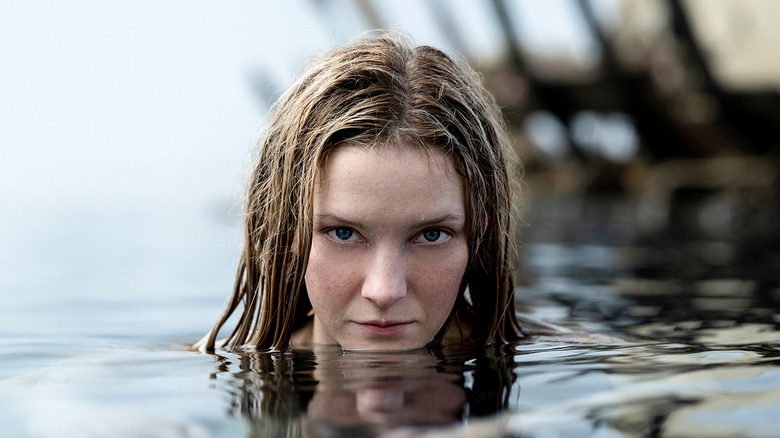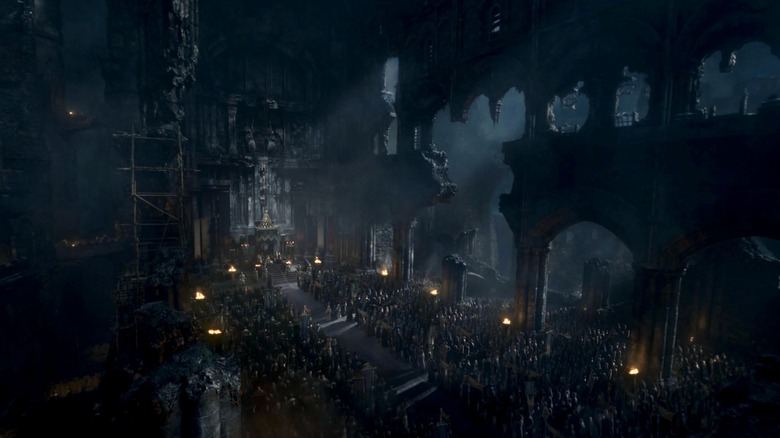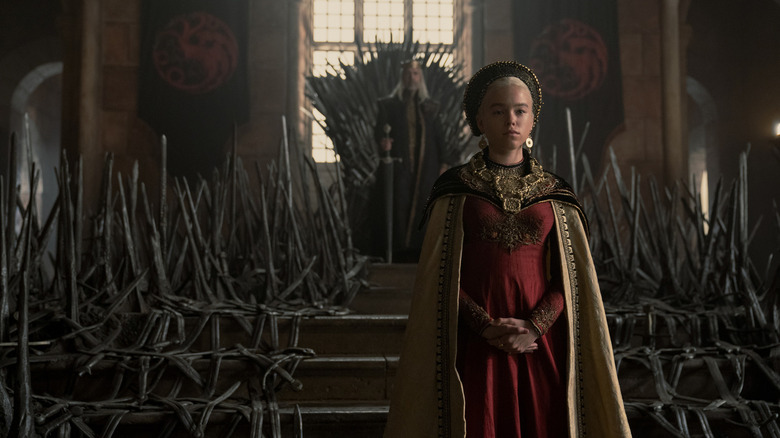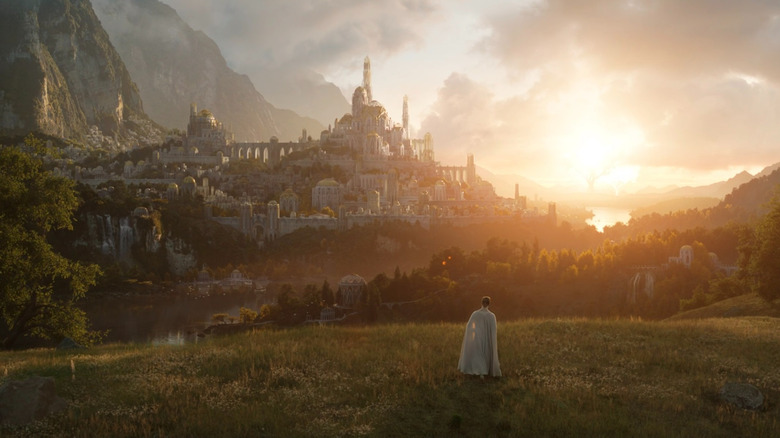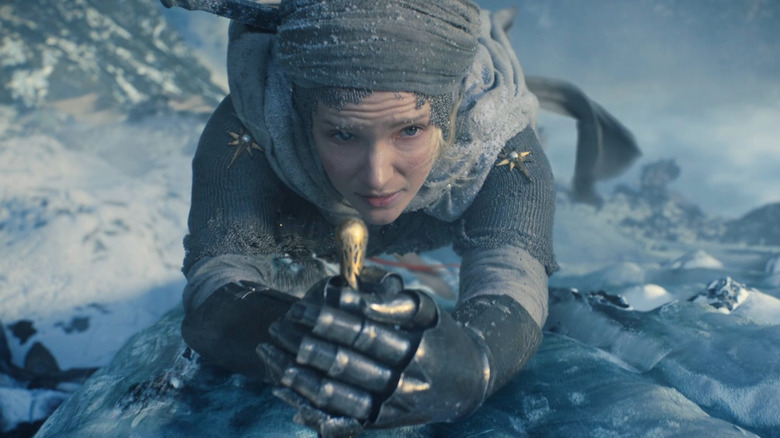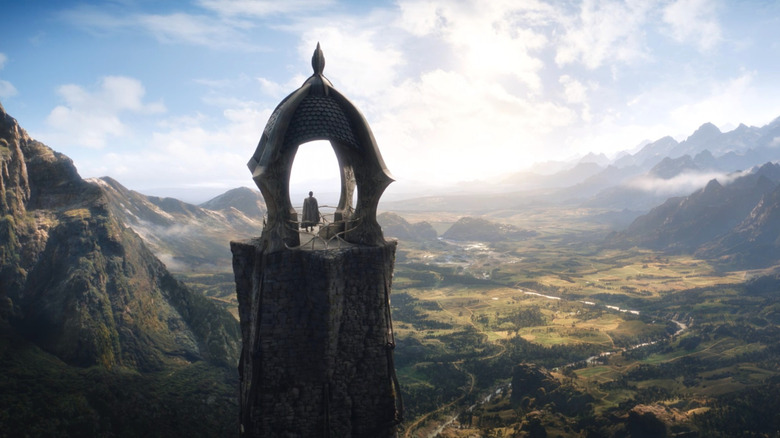How House Of The Dragon And The Rings Of Power Rebuild The Worlds Of Westeros And Middle-Earth
In the span of a week and a half, the two biggest fantasy franchises of all time have returned with HBO's "House of the Dragon" and Prime Video's "The Lord of the Rings: The Rings of Power." Both are prequel shows led by blondes who just happen to be dragon riders or immortal Elves. Both buck the Eurocentric casting of previous franchise outings with the addition of prominent Black characters. They're not exactly world-building from scratch, since we've been to the fictional realms of Westeros and Middle-earth before. Yet as they set about annexing or rebuilding within those realms, "House of the Dragon" and "The Rings of Power" deepen our knowledge of certain spots on the map (and in the latter case, introduce new ones), simultaneously delivering drama to reestablish the ethos of "Game of Thrones" and "The Lord of the Rings."
With the first two episodes of each series now available to stream, "House of the Dragon" and "The Rings of Power" present parallel cases for how to ease new viewers and diehard fans into a prequel that doesn't immediately fall flat. They're even riding neck-and-neck on Rotten Tomatoes right now, with reviews in the range of 83% to 84%. Unroll your parchment maps (or fire up your apps) and let's take a look at how these dueling prestige fantasy shows guide us back into the worlds of George R.R. Martin's Westeros and J.R.R. Tolkien's Middle-earth, and their neighboring continents of Essos and Aman.
Spoilers are fair game for "House of the Dragon" and "The Rings of Power" after this point, as well as "Game of Thrones" and "The Lord of the Rings."
The Ghost of Harrenhal
The official HBO map of Westeros and Essos for "House of the Dragon" currently highlights three spots: Harrenhal, King's Landing, and Valyria. The show opens with voiceover narration from Emma D'Arcy, who will play the adult version of Milly Alcock's Princess Rhaenyra Targaryen when "House of the Dragon" time-jumps forward in the back half of its first season. As we see a great council gathered in a spacious, lantern-lit throne room, Rhaenyra explains that "over a thousand lords made the journey to Harrenhal" to be there as the old Targaryen king chose an heir.
The king's eldest descendent, Princess Rhaenys Targaryen (Eve Best), is notably passed over in favor of his "oldest male descendent," Prince Viserys Targaryen (Paddy Considine). Rhaenys becomes the Queen Who Never Was, which immediately shows that Westeros isn't any more ready for a woman to lead it than it would be 200 years later in "Game of Thrones." In the original series, Harrenhal was the location where Arya Stark (Maisie Williams) served as a cupbearer for Tywin Lannister (Charles Dance).
Alcock's young Rhaenyra likewise becomes a cupbearer for King Viserys, and this is but one of the many "Game of Thrones" echoes in "House of the Dragon." The ill-fated brother of Daenerys Targaryen (Emilia Clarke) in "Game of Thrones" also takes his name from Viserys. Unlike Considine's character, the Viserys we see in "Thrones" (played by Harry Lloyd) never became king, though he did get fitted for a scalding golden crown by Khal Drogo (Jason Momoa).
Back in King's Landing
The city of King's Landing, which Daenerys reduced to ash in the penultimate episode of "Game of Thrones," quickly fills with just as much court intrigue in "House of the Dragon," as various power players compete for succession (on their own or through the king's hand in marriage). This is the defining aspect of both shows and the world of Westeros as we know it: "When you play the game of thrones, you win or you die."
The Iron Throne has more swords surrounding it in "House of the Dragon" — so many that King Viserys can't sit on it without cutting himself. His first wife and Rhaenyra's mother, Queen Aemma Arryn (Sian Brooke), learns the hard way that Westeros is still inhospitable to women. The rough medieval treatment of female characters was a source of controversy in "Game of Thrones," and while "House of the Dragon" thankfully hasn't depicted sexual assault yet, it does show Aemma losing her battle on the birthing bed with a horrific C-section.
Valyria is another familiar location in "House of the Dragon;" we've explored its significance elsewhere, and the same goes for Dragonstone. Suffice it to say, seeing these places again as the setting for earlier events adds to the sense of history surrounding them and demonstrates how transient the lives of our favorite "Thrones" and "Dragons" characters are.
The only misstep with "House of the Dragon" so far has been its decision to recycle Ramin Djawadi's "Game of Thrones" opening credits music, as if it were the "Star Wars" main title theme being recapitulated across multiple prequels and sequels. It's not quite the same when it's just blood oozing from sigil to sigil in place of clockwork cities coming to life on a three-dimensional map.
Westward to Valinor
The first episode of "The Rings of Power" is heavy on map transitions, which help the viewer get their bearings and understand the geography of Middle-earth and Aman (the latter of which goes unnamed except for one important Elven region, as far as I could tell). There's even a bit of context given for each place so that we understand who lives there or where it sits directionally.
Though it's a prequel set in the Second Age, some 3,000 years before the events of "The Lord of the Rings," "The Rings of Power" features two Elves we've already met, with Morfydd Clark and Robert Aramayo taking over from Cate Blanchett and Hugo Weaving as younger versions of Galadriel and Elrond. In a bit of crossover casting, Aramayo also played the young Ned Stark on "Game of Thrones."
Like "House of the Dragon," "The Rings of Power" opens with a voiceover from the "Fellowship of the Ring" playbook. At the same time, it loops back around from the end of "The Return of the King" and shows us what's on the other side of the Sundering Seas. This is the body of water that Frodo Baggins (Elijah Wood) and company would have crossed as they sailed west to the Undying Lands, a.k.a. Valinor, a place only mentioned in "The Lord of the Rings." You may remember Annie Lennox singing "Into the West" in reference to this far-off locale.
In the "Rings of Power" prologue, we see darkness cover the land, and Galadriel explains how the Elves left their home of Valinor and went off to war, journeying to "a distant realm," which happens to be good old Middle-earth. This bridges the gap between Valinor and Middle-earth in a way we've never seen before.
All over the map
Whereas "House of the Dragon" is coming from an established TV tradition, "The Rings of Power" is taking the "Hobbit" urge to expand one novel into three films and running with that as a serialized drama based on book appendices. The good thing is, the series has the production value of a movie (as well it should, given its massive budget). Moreover, it retains the widescreen scope of Peter Jackson's "Lord of the Rings" trilogy with sweeping helicopter shots of the landscape as Galadriel pursues the once and future antagonist Sauron to the very ends of the (Middle-)earth.
In Forodwaith, "the Northernmost Waste," Galadriel scales an icy cliff next to a ginormous waterfall, reaching an abandoned stronghold reminiscent of the Mines of Moria in "The Fellowship of the Ring." There's a snow troll there instead of a cave troll, but you get the gist. With millennia of life still ahead of her, Galadriel is a very different character from the one we know. "In place of a Dark Lord, you would have..." well, not exactly a Queen, but an accomplished warrior (and swimmer) nonetheless. The real Moria appears in the second episode as the thriving Khazad-Dûm, "Realm of the Dwarves."
An early breed of Hobbits called Harfoots inhabit Rhovanion, "The Wilderness East of the Andun," where they forage for berries and intercept meteor men. All Elves go to Heaven Valinor, except Galadriel, and the ones in Lindon, "Capitol of High Elves," and the ones in Eregion, "Realm of the Elven-Smiths." Across the mountains from Lindon, meanwhile, are the doomed Southlands, "The Lands of Men" — and Women, at least one of whom carries on a forbidden romance with an Elf in a forward-looking callback to Aragorn (Viggo Mortensen) and Arwen (Liv Tyler).
One genre to rule them all
While a huge gulf of time separates "The Rings of Power" from "The Lord of the Rings," you can see the through-line from the various Middle-earth peoples in the Second Age to the Third Age. Elves, Dwarves, Hobbits, Men, and Orcs are all there in some form, and they don't always get along or have the decency not to throw out fantasy racial epithets like "knife ears."
"Game of Thrones" will always be indebted to "The Lord of the Rings," a fact that came into focus especially in the series finale when it went all Tolkien on us. It's too early to tell yet which of these shows, "House of the Dragon" or "The Rings of Power," will have more staying power, but as Galadriel says in the first line of the latter show's premiere: "Nothing is evil in the beginning."
A little later, a Harfoot says, "Anything bad that happens the next three seasons will be our fault," and she might just as well be talking about the showrunners and writers' room. You don't have to be a fantasy expert to appreciate the world-building in "House of the Dragon" and "The Rings of Power," but it's clear that the genre is having a moment on television. And as we hear talk of building a tower — and see an Elven watchtower — all we can hope to do is climb up there and enjoy the view while it lasts.
